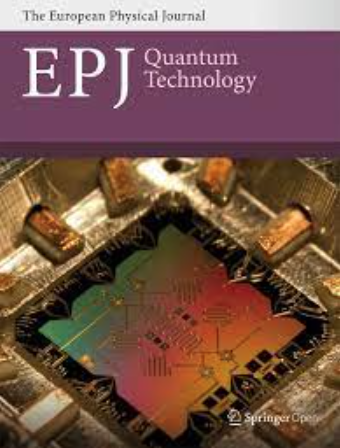Application of the QDST algorithm for the Schrödinger particle simulation in the infinite potential well
IF 5.8
2区 物理与天体物理
Q1 OPTICS
引用次数: 0
Abstract
This paper examines whether a quantum computer can efficiently simulate the time evolution of the Schrödinger particle in a one-dimensional infinite potential well. In order to solve the Schrödinger equation in the quantum register, an algorithm based on the Quantum Discrete Sine Transform (QDST) is applied. The paper compares the results obtained in this way with the results given by the previous method (based on the QFT algorithm).
将 QDST 算法应用于无限势阱中的薛定谔粒子模拟
本文研究了量子计算机能否有效地模拟薛定谔粒子在一维无限势阱中的时间演化。为了在量子寄存器中求解薛定谔方程,本文采用了一种基于量子离散正弦变换(QDST)的算法。论文将这种方法得出的结果与之前的方法(基于量子力学算法)得出的结果进行了比较。
本文章由计算机程序翻译,如有差异,请以英文原文为准。
求助全文
约1分钟内获得全文
求助全文
来源期刊

EPJ Quantum Technology
Physics and Astronomy-Atomic and Molecular Physics, and Optics
CiteScore
7.70
自引率
7.50%
发文量
28
审稿时长
71 days
期刊介绍:
Driven by advances in technology and experimental capability, the last decade has seen the emergence of quantum technology: a new praxis for controlling the quantum world. It is now possible to engineer complex, multi-component systems that merge the once distinct fields of quantum optics and condensed matter physics.
EPJ Quantum Technology covers theoretical and experimental advances in subjects including but not limited to the following:
Quantum measurement, metrology and lithography
Quantum complex systems, networks and cellular automata
Quantum electromechanical systems
Quantum optomechanical systems
Quantum machines, engineering and nanorobotics
Quantum control theory
Quantum information, communication and computation
Quantum thermodynamics
Quantum metamaterials
The effect of Casimir forces on micro- and nano-electromechanical systems
Quantum biology
Quantum sensing
Hybrid quantum systems
Quantum simulations.
 求助内容:
求助内容: 应助结果提醒方式:
应助结果提醒方式:


